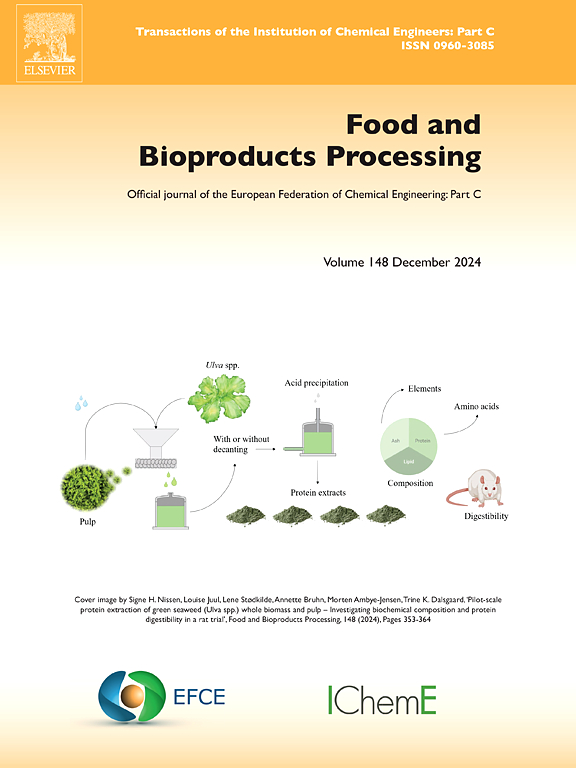Exploring the chemical potential of ‘Vinhão’ grape stalks for circular economy applications
IF 3.4
2区 农林科学
Q2 BIOTECHNOLOGY & APPLIED MICROBIOLOGY
引用次数: 0
Abstract
The Portuguese wine industry produces tons of waste annually, during processing, this waste accumulates, leading to problems such as attracting pests and unpleasant odors. This waste is burned in the open, releasing greenhouse gases and heat into the atmosphere, causing damage to the environment. Among the various residues generated in the production of wine, the grape stalks stand out, the structure of the bunch removed before the winemaking process.The study explores the chemical characterization of grape stalks (G.S.) from Portuguese ‘Vinhão’ red grapes, aiming to upcycle wine industry residues in a circular bioeconomy framework. The analyses performed for this raw material (G.S.) were proximal composition, total phenolics, antioxidant activity, colorimetry, Fourier Transform Infrared Spectroscopy with Attenuated Total Reflectance (FTIR-ATR), fatty acid and mineral profile. Dried and milled stalks were analyzed for moisture (5.31 %), ash (7.67 %), lipids (0.60 %), protein (3.28 %), and insoluble fiber (55.00 %). With the results of the antioxidant activity, the extract obtained from grape stems, about the DPPH (0.64 mmol Trolox. g−1) and ABTS (0.39 mmol Trolox. g−1) radicals, resulted in an expressive capacity to neutralize free radicals, providing a significant antioxidant potential. These findings suggest that the compounds present in the extract may contribute to the reduction of oxidative stress, making it a promising alternative for applications in the food and pharmaceutical industries. FTIR confirmed lignin, polysaccharides, and polyphenolics. Fatty acid profiling revealed that linoleic acid (PUFA, 34.80 %) and oleic acid (MUFA, 14.48 %) were major components. Mineral analysis showed high levels of Mn, Fe, and Mg, surpassing recommended daily intakes. These findings highlight the potential of ‘Vinhão’ stalks as sustainable food and feed supplements, reducing waste and enhancing wine industry circularity.
探索“vinh”葡萄梗在循环经济中的化学势
葡萄牙葡萄酒行业每年产生大量的废物,在加工过程中,这些废物积累起来,导致诸如吸引害虫和难闻的气味等问题。这些废物露天燃烧,将温室气体和热量释放到大气中,对环境造成破坏。在葡萄酒生产过程中产生的各种残留物中,葡萄茎突出,在酿酒过程之前,葡萄束的结构被去除。该研究探讨了葡萄牙“vinh”红葡萄葡萄梗(G.S.)的化学特性,旨在在循环生物经济框架下对葡萄酒行业残留物进行升级利用。对该原料(G.S.)进行了近端成分、总酚类物质、抗氧化活性、比色法、傅立叶变换红外光谱(FTIR-ATR)、脂肪酸和矿物谱分析。对干燥和碾磨后的秸秆进行水分(5.31 %)、灰分(7.67 %)、脂质(0.60 %)、蛋白质(3.28 %)和不溶性纤维(55.00 %)分析。用抗氧化活性的结果表明,从葡萄茎中得到的提取物,约为DPPH(0.64 mmol Trolox)。g−1)和ABTS(0.39 mmol Trolox。G−1)自由基,导致表达能力,以中和自由基,提供显著的抗氧化潜力。这些发现表明,提取物中存在的化合物可能有助于减少氧化应激,使其成为食品和制药行业应用的有希望的替代品。FTIR证实木质素、多糖和多酚类物质。脂肪酸分析显示亚油酸(PUFA, 34.80 %)和油酸(MUFA, 14.48 %)是主要成分。矿物质分析显示,锰、铁和镁的含量很高,超过了推荐的每日摄入量。这些发现突出了“vinh”秸秆作为可持续食品和饲料补充的潜力,减少了浪费,增强了葡萄酒行业的循环性。
本文章由计算机程序翻译,如有差异,请以英文原文为准。
求助全文
约1分钟内获得全文
求助全文
来源期刊

Food and Bioproducts Processing
工程技术-工程:化工
CiteScore
9.70
自引率
4.30%
发文量
115
审稿时长
24 days
期刊介绍:
Official Journal of the European Federation of Chemical Engineering:
Part C
FBP aims to be the principal international journal for publication of high quality, original papers in the branches of engineering and science dedicated to the safe processing of biological products. It is the only journal to exploit the synergy between biotechnology, bioprocessing and food engineering.
Papers showing how research results can be used in engineering design, and accounts of experimental or theoretical research work bringing new perspectives to established principles, highlighting unsolved problems or indicating directions for future research, are particularly welcome. Contributions that deal with new developments in equipment or processes and that can be given quantitative expression are encouraged. The journal is especially interested in papers that extend the boundaries of food and bioproducts processing.
The journal has a strong emphasis on the interface between engineering and food or bioproducts. Papers that are not likely to be published are those:
• Primarily concerned with food formulation
• That use experimental design techniques to obtain response surfaces but gain little insight from them
• That are empirical and ignore established mechanistic models, e.g., empirical drying curves
• That are primarily concerned about sensory evaluation and colour
• Concern the extraction, encapsulation and/or antioxidant activity of a specific biological material without providing insight that could be applied to a similar but different material,
• Containing only chemical analyses of biological materials.
 求助内容:
求助内容: 应助结果提醒方式:
应助结果提醒方式:


